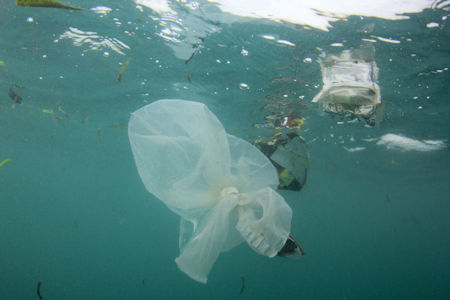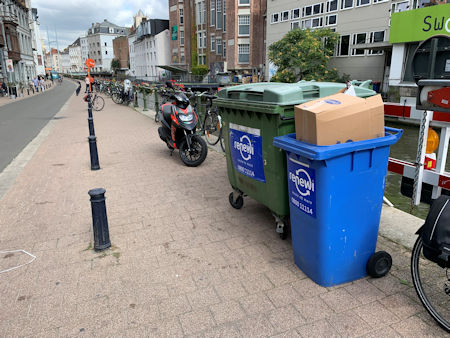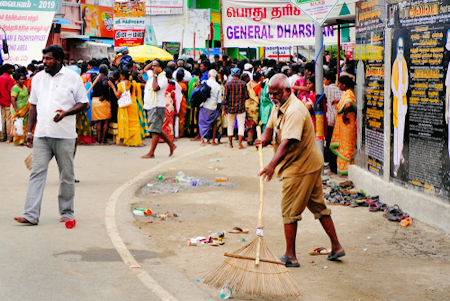Pay as you throw; the public walking into waste collectors; plastics in the sea; and reducing needs to reduce resource use: all these and more were on the agenda of the latest ISWA Congress, as reported by Jeff Cooper, a former ISWA and CIWM president.
The 29th ISWA Congress took place at the Euskalduna Congress Centre in the northern Spanish city of Bilbao, 7-9 October with over 1,200 participants from more than 75 countries.

The 2019 conference of the International Solid Waste Association was held in Bilbao. Pictured, the dog sculpture outside the city’s Guggenheim museum (picture: Shutterstock)
Bilbao itself is a testament as to how dramatic environmental transformations can be achieved in a short space of time with sustained management. Bilbao has gone from the position as one of the most heavily industrialised and polluted places in Europe to becoming a high tech and innovation centre with a completely revitalised urban landscape, centred on the Guggenheim Museum and the Jeff Koons’ 15m high flower puppy at its entrance.
Keynote Speeches
The Congress started with some scene-setting on two issues which have been crucial to ISWA’s work of the past few years: marine litter and climate change. Charles Moore of the Algalita Marine Research Foundation in southern California explained that there are now 5 plastics gyres that cover a quarter of the Earth’s surface. He was also sceptical about the idea of skimming plastic from the ocean would be an effective solution. The best approach is to stop plastic waste entering the marine environment from rivers. ISWA’s research on providing a marine litter calculator is designed to do precisely that. It has been tested out in Bali, which suffers from the effects of marine litter on its beaches generated both from the island and washed up from elsewhere, which in turn affects its attractiveness as a tourist destination.

Stopping plastics entering the sea from rivers is the best solution to protect the sea, the conference heard (picture: Shutterstock)
The second key-note presentation from Dr Mario Picazo of Pelmorex Media, who reinforced the concern that we are doing too little to mitigate GHG emissions that are producing warmer and more freakish weather situations throughout the World. ISWA has had a decade long standing campaign to enhance all aspects of waste management and for the last 7 years to close dumpsites and in order to reduce GHG emissions.
Two new publications were launched at the congress: Closing dumpsites, climate benefits due to dumpsite closure – three case studies and ISWA landfill operational guidelines, 3rd edition. In addition, the Biological Treatment of Waste Working Group has been conducting research on the benefits of carbon sequestration arising from the treatment of organic waste and its incorporation into soils, which of course has a multitude of other benefits as well. The results of this research will be reported on at a conference in Oman 10-12 February 2020.
Taking up the theme of the Congress, ‘Circular Economy – what are you doing?’, the third keynote speaker, Nicola Cerantola from the Spanish research company Ecologing, examined the vexed question of how we achieve a more circular economy. He noted that the whole of the World is focussed on continuing with slightly modified business models which will demand exploitation of more resources, even if we manage to achieve greater recovery and recycling of existing materials. Mr Cerantola suggested we should be redefining and reducing our needs and to help with that task requires a new concept of values.
Conference Presentations
The Congress had more than 250 presentations with no fewer than 8 parallel sessions so it was difficult to select an ideal personal programme. The first session included presentations on the use of pay as you throw as an instrument for better resource management in Cities. Currently there is a Horizon 2020 research programme running to examine how PAYT is best implemented (pay as you throw – PAYT Toolkit for European Cities). Most of the contributions in this session reported on findings of various projects that had been funded by that programme.
John Egil Nilssen from Oslo City Council described the background work he had conducted on the issue in the context of Oslo’s problem of moving beyond its 37% recyclables capture rate where it had plateaued for the past 5 years. Would PAYT help to raise the recovery rate? Mr Nilssen had examined 72 peer-reviewed articles on PAYT published between 2002 and 2019. PAYT did not provide a silver bullet, indeed his conclusions were that there were a number of other options that might be better than PAYT or should be utilised to improve the performance of PAYT, such as reducing residual waste collections and enhancing those for recyclables, better communication strategies and follow-up actions, including enforcement. However, he admitted in later discussions that he had relied on the results of published papers and had not consulted waste managers, especially in North America where much of the practical experience of PAYT has often not been researched for peer-reviewed publications.
A further Norwegian city, Bergen in 2010 introduced RFID tagged bins and introduced PAYT for residual waste using a fixed fee for the collection service and a variable fee dependent on the amount of waste presented for collection. According to Per Heiberg-Andersen the system has worked well with residual waste declining and greater recovery of recyclables. However, he stressed that it required more work on consumer attitudes, making the service very convenient to use as well as the economic incentives to ensure the scheme worked efficiently.
Michele Giavini and Marta Vila reported on their series of projects under the EU-funded Waste4Think project. One of their study towns was Seveso, the setting for a dramatic hazardous waste incident in 1967. Seveso already had a good record with waste diversion with 70% recovery for recycling in 2017. With the introduction of PAYT the diversion rate increased to 84%.
Most people were using their RFID tagged bags for residual waste only once or twice a month. The bags cost €2.30 for a 110 litre capacity bag. However, the overall waste treatment savings were estimated at €1.76 pppa but the cost was in excess of €5 pppa. Therefore for communities achieving high diversion nudges other than PAYT may be more cost effective?
Flemish region, Belgium
There was also a presentation by Christof Delatter of the Flemish Regional Government Waste Agency, Interval. This is an EU region which endorsed the use of PAYT at an early stage so that its 300 municipalities have all adopted PAYT, albeit with pricing variations depending on local circumstances with waste collection efficiencies. As is universally acknowledged the Flemish Region of Belgium has set the standard for source segregation of waste and this extends also to its CA sites as well. However, the Regional government has recently set parameters within which PAYT for both domestic collections and delivery to CA sites need to be set.
“There was an increasing number of incidents due to people speaking on their mobile phones or texting and running into operative staff”
For the first time there was an emphasis at the Congress on the issue of health and safety issues for waste management staff. The session was moderated by David Biderman, CEO of SWANA (the Solid Waste Association of North America) who described the situation in the US. He identified a number of factors which have exacerbated fatalities in the waste sector having seen a decreasing trend until a decade ago but since then increases. There was an increasing number of incidents due to people speaking on their mobile phones or texting and running into operative staff or being too impatient to wait for a suitable passing opportunity.
Lithium Ion
Also David Biderman noted lithium ion batteries were starting to show up as the cause of fires in vehicles or waste treatment facilities The trends in North America are parallel to those in Europe and with the solutions to problems with waste workers’ H&S issues focussed on employee training, ensuring others are aware the presence of collection vehicles and signage on vehicles. Dr Toni Gladding of the Open University and Secretary to the WISH Forum in the UK followed up with the British perspectives on the subject.
India
A most memorable presentation in this session was from Vivek Agrawal from ISWA India. He stated that the Indian Prime Minister, Narendra Modi had committed to improve waste management in the whole of India when coming into power in 2014. Although there are changes happening the workers’ conditions are not being prioritised. However, they do now have better brooms for street cleaning because in the past often hand brushes were used which cause muscular skeletal problems.
Dr Agrawal also outlined a number of other health issues that afflict workers in the Indian waste sector and probably therefore the rest of the developing countries’ workers. He went on to argue that the International Labour Organisation ought to regard work with waste as a hazardous occupation in order to provide greater protection and better screening programmes for workers.
Related links
ISWA
(A second part report on Extended Producer Responsibility discussions at the ISWA event will be published by letsrecycle.com shortly)
The post ISWA Congress in Bilbao 2019 appeared first on letsrecycle.com.
Source: letsrecycle.com Waste Managment




